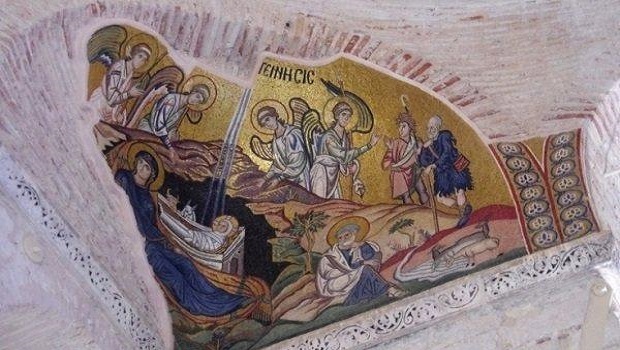Professor Mihaïl Tritos, School of Theology A.U.Th.
No other text is able to express with such force and fulness the redemptive, existential and metaphysical dimension of the resurrection so well as the incomparable canon by Saint John the Damascan.
It’s a masterpiece of Byzantine poetry and one of the most wonderful texts in the whole of world literature. Full of lyrical expressions of sublime spirituality and messages of salvation, the Damascan’s canon announces to people in all eras ‘the glad tidings of the resurrection’, the abolition of death, the plenitude of life and the eschatological triumph. In particular, however, it describes the dimensions and quality of the joy of the resurrection; it points out the way and sets the necessary conditions for us to see the risen Lord; and it strengthens people in their efforts to overcome natural and moral wickedness by the vision and certainty of participation ‘in the unwaning day of his kingdom’.
Wonderful poetical expressions, the choice of the most impressive vocabulary in the rich Greek language, the fervent breath of faith and hope and, particularly, a plethora of powerful experiences of life are the main elements which form the grandeur of this wonderful canon.
A noticeable, basic element in the hymn is the prefigurations of the resurrection in the Old Testament, which are to be found throughout the troparia of the canon. It is with these what we shall deal in this present, festal article.
The first Old Testament prefiguration of the resurrection is in the irmos of the first ode of the canon and has to do with the word pascha. It’s common knowledge that the Hebrew word pesach means passover. For the Jews this meant their deliverance from slavery to the Egyptians and their establishment in the promised land. For Christians, pascha means a passover from death to life, from enslavement to sin to liberty as children of God, from the negative forces of the world to the positive forces of the resurrection. And, just as the Jews who were redeemed from slavery to Pharaoh sang a hymn of victory, in a similar manner the new Israel of grace sings a hymn of triumph, since our risen Lord ‘has led us over from death to life and from earth to heaven’. As Saint Gregory the Theologian writes: ‘This passover, this great and venerable event, pesach to the Jews in their language, denotes historically the passover, the flight from Egypt and the migration to Canaan. Spiritually, it proclaims the progress and ascent from below to above, to the promised land’.
The second prefiguration of the resurrection is the ‘new drink, not one drawn miraculously from the ‘barren rock’, as the hymnographer saint puts it in the irmos of the third ode. According to the Biblical narrative of Exodus, when the Israelites thirsted in the wilderness, Moses struck the barren rock with his staff, causing abundant water to well up, allowing the Israelites to slake their thirst. This event prefigures the ‘new drink’ which flows from the life-bearing tomb in Jerusalem and which is the source of incorruption. This is the sacrament, inaugurated by God, of the divine eucharist, the pre-eminent paschal feast of the Church, which is provided ‘for the remission of sins and life everlasting’. Through this, the faithful experience the astonishing passing over into a new reality, ‘the first-fruits of the other, eternal life’.
In the irmos of the fourth ode and with unique poetic artistry, Saint John calls upon the Prophet Habakkuk to proclaim the resurrection. In order to receive the office of prophet, Habakkuk stood at his watch and mounted a rock. Here he’s called upon to stand on a spiritual rock and show people the ‘luminescent angel’, who stands beside the empty tomb and to announce to the world that ‘Christ has risen as [being] all-powerful’.
In the third tropario of the same ode, Christ is called the ‘yearling lamb’. In order to remember their deliverance from slavery to the Egyptians, the Jews sacrificed the passover lamb, which was a yearling. This lamb was a prefiguration of the Lamb in the New Testament, Jesus Christ, who was sacrificed ‘for the life and salvation of the world’. The consumption of the passover lamb prefigures the sacrament of the divine eucharist, at which the Lamb of God is offered ‘as food and drink to the faithful’.
The fourth tropario of the fourth ode draws a parallel between the prophet-king David and the people of God. Just as David danced with joy when he brought the Ark of the Covenant from the city of Jearim to Jerusalem, so, too, the Christian congregation of the Church rejoices at the sight of the ‘fulfillment of the symbols’ being accomplished at the great event of the resurrection. The Church, as the new ark of grace, was founded on the power of the cross and the resurrection, which is why it’s unshakeable and enduring.
The vicissitudes of Jonah are presented in the irmos of the sixth ode as being one of the most important prefigurations of the resurrection. In the familiar narrative, Jonah was given a command from God to preach repentance in the city of Nineveh. But he disobeyed the divine command and boarded a ship to take him to Tarshish. For this, he was punished by God. The ship on which he was travelling was in danger of foundering, so, conscious of his sinfulness, he asked the crew to cast him into the sea, which they did. At God’s behest, a monster of the deep swallowed him and he remained for three days and three nights in the animal’s belly. In the end, the huge animal cast Jonah up on dry land, so that he was able to go to Nineveh and carry out God’s order. Jonah’s sojourn in the belly of the monster and his miraculous emergence from it are prefigurations of the three-day burial and resurrection of Christ. The Lord himself said: ‘For as Jonah was three days and three nights in the belly of a sea monster, so the Son of Man will be three days and three nights in the heart of the earth’ [Matthew 12, 40].
Moses had named the great day of the Jewish passover ‘appointed’ and ‘holy’. ‘And the first day shall be called holy and the seventh day shall be a holy convocation to you’. The day of the Jewish passover is designated ‘appointed’* because it was selected by God himself. It’s ‘holy’ because it’s dedicated to him. Saint John uses the terms ‘appointed’ and ‘holy’ in the irmos of the eighth ode of the Easter canon. It’s designated as ‘appointed’ because it constitutes ‘eternal Sabbath observance, the eighth day, as the first fruits of the sacramental time of the kingdom, as the starting-point for the renewal of all things’. It’s ‘holy’ because it’s the day above all others which is dedicated to the Lord.
In the irmos of the ninth ode, the hymnographer poetically develops the prophecy of Isaiah and adapts it to the glory of the resurrection within the Church: ‘Arise, shine, for your light has come and the glory of the Lord has risen upon you’. In the irmos, this becomes: ‘Shine, shine, new Jerusalem, for the glory of the Lord has risen upon you’. The words ‘new Jerusalem’ refer to the Church and the ‘glory of the Lord’, is Christ’s glorious resurrection, from which divine glory proceeds.
Christ’s resurrection, which is depicted wonderfully in the Easter canon through prefigurations from the Old Testament, is a triumphant event of universal importance and power. Through the resurrection, the power of the devil is crushed, death is put to death, decay is no more. This is why it’s the ‘feast of feasts and the festival of festivals’. Saint Gregory the Theologian justifiably proclaims: ‘Today salvation has come to the world, to both the visible and the invisible world. Christ has risen from the dead, rise with him. Christ has returned again to himself, return also. Christ is freed from the tomb, free yourselves from the shackles of sin. The gates of hell are opened, death has been destroyed; the old Adam has been cast off, and the new has been effected. If anyone is in Christ, they are a new creation; renew yourselves…’.
Source: agiazoni.gr
*Usually translated as ‘chosen’, which is perfectly reasonable, but, alas, not quite accurate. The problem is that the word ‘kliti’ is not, here, an adjective- ‘appointed’ – describing ‘day’, but a noun, meaning ‘convocation’. The basic root in Greek is the verb ‘kaleô’ which means to call-‘shall be called’-, or to invite, to convoke. The Masoretic Hebrew text has ‘miq’rä-qodesh’ (‘convocation’) twice (‘And in the first day there will be to you a holy convocation and in the seventh day a holy convocation’), but the translators of the Septuagint, on which the canon is based, may have been working from a different text or perhaps wanted to avoid repetition. The same root,‘kaleô’, also gives us ‘ekklisia’ (ecclesia) ‘a calling out’, which is the Greek for ‘Church’. WJL.
Source: pemptousia.com




0 Comments